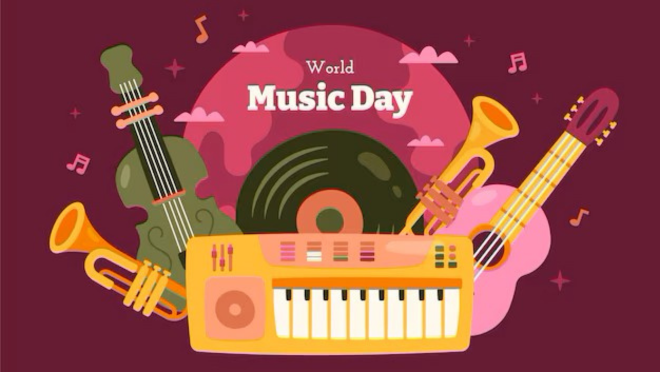World Music Day: Surprising origins of instruments we know and love
World Music Day: Surprising origins of instruments we know and love

Most people don’t really think about where musical instruments come from. A guitar is a guitar. A piano is just a piano. But behind these familiar instruments lie surprising stories—of migration, invention, and pure coincidence.
This World Music Day on 21 June, it’s worth taking a closer look at how some of the most popular instruments ended up in our hands. What we find isn’t just about music. It’s about how cultures meet, how ideas travel, and how creativity adapts over time.
Guitar
The guitar, today a global icon, began its journey far from the rock genre it represents. Its earliest ancestor is the oud, a fretless, pear-shaped lute from the Arab world. The Moors brought it to Spain in the 8th century.
Spanish instrument makers started adapting it, merging features of the oud with local instruments like the vihuela. Over centuries, the guitar evolved into something flatter, fretted, and more portable. By the 18th century, it had taken a form similar to what we know today—though it was smaller and used gut strings.
Modern innovations like steel strings and electric pickups came much later, shaped by industrial metalwork and American jazz.
Piano
The piano didn’t start with a bang. It started with a problem.
In the early 1700s, Bartolomeo Cristofori, a harpsichord technician in Florence, was trying to give musicians more control over volume. Harpsichords could only pluck strings, which meant the same loudness no matter how softly you played.
Cristofori replaced the plucking mechanism with felt-covered hammers that struck the strings. This allowed both soft and loud notes—hence it was initially called gravicembalo col piano e forte (“keyboard instrument with soft and loud”). That’s how the piano eventually got its name.
What followed was a long evolution. Iron frames, heavier strings, and mass production turned it from a fragile salon instrument into the grand piano we now associate with concert halls. But its core idea—a hammer striking a string—remains unchanged.
Violin
Violins feel like they’ve always been here. But they, too, came from a long line of simpler instruments.
The earliest versions include the ravanahatha from India and the rebab from the Arab world. These bowed lutes spread into Europe during the Middle Ages, where they became the rebec.
It was in 16th-century Italy—particularly in Cremona—that the violin took on its modern form. Makers like Andrea Amati, and later Stradivari, shaped its body, tuned its tone, and refined its curves. Their designs are still used today, with very few changes.
Though it started as a modest folk instrument, the violin became a mainstay of orchestras, solo stages, and nearly every genre that followed.
Drums
The drum kit is surprisingly modern. Before the 20th century, bands needed multiple people to play bass drums, snare drums, and cymbals.
That changed in the late 1800s, especially in New Orleans, where space in dance bars was tight. Drummers began experimenting with ways to play everything themselves. One breakthrough was the bass drum pedal, which let them use their feet while their hands were busy.
The rest of the kit came together through trial, error, and practicality. Tom-toms were added. Cymbals moved onto stands. When jazz, rock, and studio recording took off, so did the demand for compact, flexible kits.
Saxophone
Unlike most instruments, the saxophone doesn’t have ancient roots. It was invented by one man: Adolphe Sax, a Belgian instrument maker, in 1846.
Sax wanted an instrument that combined the power of brass with the flexibility of woodwinds. So he created a brass-bodied tube with a single reed, like a clarinet. He called it the saxophone.
At first, it found a home in military bands. But classical musicians hesitated. It wasn’t until jazz musicians in the U.S. adopted it that the sax took off. By the 1920s, it was everywhere—from swing to bebop.
Flute
The flute may be the oldest instrument still in regular use. The oldest known flute, found in Germany, is over 40,000 years old. It was made from the hollow bone of a bird, with carefully drilled holes. Other early flutes have been found in China and Mesopotamia, dating back thousands of years.
Modern flutes changed shape during the 1800s, when Theobald Boehm developed a metal version with a new key system.
Accordion
The accordion might be best known for its role in Latin American folk music, but its origin is European.
In 1829, Cyrill Demian of Vienna patented the first “accordion”. It was a small, hand-held box with buttons and bellows—like a compressed organ. Though it started in Austria, it travelled fast.
Immigrants carried it to South America, where it became central to Colombian vallenato and Mexican norteño. In Louisiana, it became a core part of Cajun and zydeco music. Its loud, reedy sound made it perfect for dancing, especially in noisy spaces.
Synthesiser
The synthesiser is the youngest instrument on this list. It doesn’t use wood, strings, or air. It uses electricity.
Early versions came in the early 1900s—the theremin and Ondes Martenot were among the first. But the real breakthrough came in the 1960s, when Robert Moog built the first voltage-controlled synthesiser.
Moog’s invention let musicians shape sound with knobs and keys, simulating everything from violins to drums. The synth quickly became a favourite in rock, disco, and later electronic music. Today, it powers everything from pop hits to movie scores.
Instruments don’t just emerge from nowhere. They are the result of migration, invention, problem-solving, and, often, sheer luck. What we now call “traditional” was once new, strange, and even controversial.
As we enjoy the music on World Music Day, remember that every instrument has a unique and often surprising past. From ancient bones to clever inventions and from distant lands to global stages, each instrument tells a story of human creativity and our endless passion for making beautiful sounds. The music we hear today is built on these incredible journeys through time.


